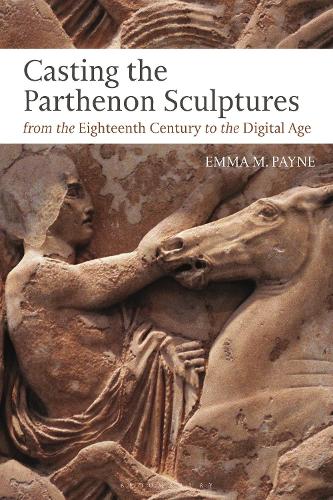
Casting the Parthenon Sculptures from the Eighteenth Century to the Digital Age
(Hardback)
Available Formats
Publishing Details
Casting the Parthenon Sculptures from the Eighteenth Century to the Digital Age
By (Author) Dr Emma M. Payne
Bloomsbury Publishing PLC
Bloomsbury Academic
3rd June 2021
United Kingdom
Classifications
Tertiary Education
Non Fiction
Travel guides: museums, historic sites, galleries etc
History of art
731.45209
Physical Properties
Hardback
224
Width 156mm, Height 234mm
494g
Description
Through the 19th century, as archaeology started to emerge as a systematic discipline, plaster casting became a widely-adopted technique, newly applied by archaeologists to document and transmit discoveries from their expeditions. The Parthenon sculptures were some of the first to be cast. In the late 18th century and the first years of the 19th century, the French artist Fauvel and Lord Elgins men conducted campaigns on the Athenian Acropolis. Both created casts of parts of the Parthenon sculptures that they did not remove and these were sent back to France and Britain where they were esteemed and displayed alongside other, original sections. Henceforth, casting was established as an essential archaeological tool and grew exponentially over the course of the century. Such casts are now not only fascinating historical objects but may also be considered time capsules, capturing the details of important ancient works when they were first moulded in centuries past. This book examines the role of 19th century casts as an archaeological resource and explores how their materiality and spread impacted the reception of the Parthenon sculptures and other Greek and Roman works. Investigation of their historical context is combined with analysis of new digital models of the Parthenon sculptures and their casts. Sensitive 3D imaging techniques allow investigation of the surface markings of the objects in exceptionally fine detail and enable quantitative comparative studies comparing the originals and the casts. The 19th century casts are found to be even more accurate, but also complex, than anticipated; through careful study of their multiple layers, we can retrieve surface information now lost from the originals through weathering and vandalism.
Reviews
Payne is to be praised for raising the profile of archaeological casts as a source of information about the often endangered objects they reproduce and she demonstrates how modern digital technology can be used to read them. This is a major achievement. * The Burlington Magazine *
The volume is an important and thorough introduction to the history of casting, scanning and digital production of antiquities It would provide an excellent introductory text to those unfamiliar with casting and reproduction, and Paynes discussion of complex scientific and technological terminology is concise and informative throughout; the argument is complemented by liberal illustrations. It provides a unique and much-needed new perspective in the history of the Parthenon and its artworks, enriching the field of western receptions of antiquity. * The Classical Review *
This book is an interesting research monograph, but may be worth reading for everybody who would like to learn something about the history of the Elgin marbles or about 3D scanning as well. -- Andrs Patay-Horvth, Assistant Lecturer in Ancient History, Institute of Ancient History, University Etvs Lornd, Hungary
Author Bio
Emma M. Payne is a Visiting Research Fellow at King's College London, UK.
